Full SDK (Web) Implementation
This page provides a step-by-step guide to implement and enable Yuno's Full Web SDK functionality in your application.
Changelog Reference:This guide covers the current SDK version. For details on previous versions, see the changelog.
Step 1: Include the library in your project
Add the following script tag to your HTML file to include the Yuno Web SDK:
<script src="https://sdk-web.y.uno/v1.4/main.js"></script>Alternatively, you can install it via npm:
npm install @yuno-payments/sdk-webAfter completing the SDK integration, proceed with the following steps to implement the full checkout functionality.
TypeScript LibraryIf you are using TypeScript, Yuno provides a library to see all methods available in the Yuno Web SDK.
Step 2: Initialize SDK with the public key
Create an instance of the Yuno class by providing a valid PUBLIC_API_KEY. See the credentials page for more information.
Initialize the SDK with your public API key:
const yuno = await Yuno.initialize(PUBLIC_API_KEY);Step 3: Start the checkout process
Use the yuno.startCheckout function to start the checkout process with the necessary parameters.
See the Parameters table below for all the options you can use with startCheckout.
For further customization or advanced/optional settings, see the Complementary Features section.
Parameters
The following table lists all the available parameters for the startCheckout method with descriptions:
| Parameter | Description |
|---|---|
checkoutSession | Refers to the current payment's checkout session. Example: '438413b7-4921-41e4-b8f3-28a5a0141638' |
elementSelector | The element where the SDK will be mounted. |
countryCode | This parameter specifies the country for which the payment process is being set up. Use an ENUM value representing the desired country code. You can find the full list of supported countries and their corresponding codes on the Country Coverage page. |
language | Language for payment forms. Use any code listed in Supported languages. Example: en-US. Defaults to browser language when available. |
onLoading | Required to receive notifications about server calls or loading events during the payment process. |
showLoading | Control the visibility of the Yuno loading/spinner page during the payment process. By default, it's true. |
issuersFormEnable | Enables the issuer's form. By default, it's true. |
showPaymentStatus | Shows the Yuno Payment Status page. You can use this option when continuing a payment as well. By default, it's true. |
card.isCreditCardProcessingOnly | Enables you to ensure that all card transactions are processed as credit only. This option is helpful in markets such as Brazil where cards can act as both credit and debit. To enable, set the isCreditCardProcessingOnly to true to ensure that all card transactions are processed as credit. This parameter is not required. |
yuno.startCheckout({
checkoutSession: "438413b7-4921-41e4-b8f3-28a5a0141638",
elementSelector: "#root",
countryCode: "FR",
language: "fr-FR",
showLoading: true,
issuersFormEnable: true,
showPaymentStatus: true,
card: {
isCreditCardProcessingOnly: true,
onChange: ({ error, data }) => {
if (error) {
console.log('Card form error:', error);
} else {
console.log('Card form data:', data);
}
},
},
onLoading: (args) => {
console.log(args);
},
yunoPaymentMethodSelected: () => {
console.log("Payment method selected");
},
yunoPaymentResult: (status) => {
console.log("Payment result:", status);
},
yunoError: (message, data) => {
console.error("Payment error:", message, data);
},
async yunoCreatePayment(oneTimeToken) {
await createPayment({ oneTimeToken, checkoutSession });
yuno.continuePayment({ showPaymentStatus: true });
},
});
Rendering ModeBy default, Yuno SDK renders as a modal. However, you can specify the element where the SDK will render. For additional information, access Render mode under the complementary features page.
onPaymentMethodSelectedEventFor all APMs, including Google Pay, Apple Pay, and PayPal,
onPaymentMethodSelectedis triggered as soon as the customer chooses the payment method (before the payment flow begins). DefineonPaymentMethodSelectedinstartCheckoutbeforemountCheckout.
For PayPal, the payment sheet now opens immediately after the shopper selects PayPal—no extra confirmation click required.
Google Pay and Apple Pay DisplayFrom SDK version 1.5, Google Pay and Apple Pay appear as direct buttons instead of radio buttons in the payment methods list. They are displayed separately from other payment methods.
Step 4: Mount the SDK
Display the payment methods:
yuno.mountCheckout();Mount with a default payment method selected:
yuno.mountCheckout({
paymentMethodType: PAYMENT_METHOD_TYPE,
vaultedToken: VAULTED_TOKEN,
});Step 5: Initiate the payment process
Call yuno.startPayment() to initiate the payment flow after the user selects a payment method:
const PayButton = document.querySelector("#button-pay");
PayButton.addEventListener("click", () => {
yuno.startPayment();
});Step 6: Get the OTT (one-time token)
After the customer fills out the requested data in Yuno's payment forms, the SDK provides the one-time token. The configuration function yuno.CreatePayment(oneTimeToken) is then triggered with the one-time token.
yunoCreatePayment(oneTimeToken);You can also use tokenWithInformation to receive additional information provided by the customer in the checkout, such as installments or document type/number:
yunoCreatePayment(oneTimeToken, tokenWithInformation);
Loader ManagementThe merchant is responsible for managing the loader. Yuno provides a default loader option, but merchants may implement their own loader if preferred. In that case, they are responsible for making the necessary configurations.
Step 7: Create the payment
After completing the previous steps, proceed to create a payment. Back-to-back payment creation must be performed using the Create Payment endpoint. The merchant's backend should call this endpoint to create the payment in Yuno using the one-time token and checkout session.
Complete the IntegrationAfter Step 7, you have successfully implemented the basic payment flow. To test your integration, create a test payment using the checkout session and one-time token. For additional features and advanced configurations, see the Complementary Features section below.
ContinuePaymentmethodAfter creating a payment, Yuno requires you to integrate the
continuePaymentmethod from the SDK. This is necessary because some asynchronous payment methods require additional customer actions to complete the process. The API response will indicate this scenario by setting thesdk_action_requiredfield to true. When this occurs, you must callyuno.continuePayment(), which will automatically present the necessary screens to the customer, allowing them to complete the payment flow without requiring you to handle each case manually.
continuePayment return value or null
continuePayment return value or nullFor payment methods that require merchant-side action (e.g., when the payment provider requires a redirect URL in a webview), the await yuno.continuePayment() method returns either an object with the following structure or null:
{
action: 'REDIRECT_URL'
type: string
redirect: {
init_url: string
success_url: string
error_url: string
}
} | nullWhen the method returns an object, you can handle your application's payment flows that require custom redirect handling. When it returns null, no additional merchant-side action is needed.
Demo AppIn addition to the code examples provided, you can access the Demo App for a complete implementation of Yuno SDKs. The demo app includes working examples of all Yuno SDKs and can be cloned from the GitHub repository.
Complementary features
Yuno Web SDK provides additional services and configurations you can use to improve customers' experience:
Mount external buttons
You can use the mountExternalButtons method to render Google Pay and Apple Pay buttons in custom locations within your UI. This gives you control over where these buttons are displayed.
await yuno.mountExternalButtons([
{
paymentMethodType: 'APPLE_PAY',
elementSelector: '#apple-pay',
},
{
paymentMethodType: 'GOOGLE_PAY',
elementSelector: '#google-pay',
},
]);Parameters
| Parameter | Description |
|---|---|
paymentMethodType | The payment method type. Must be either 'APPLE_PAY' or 'GOOGLE_PAY'. |
elementSelector | The CSS selector for the HTML element where the button should be rendered (e.g., '#apple-pay', '.button'). |
Unmounting buttons
You can unmount a single external button by payment method type:
yuno.unmountExternalButton('APPLE_PAY');Or unmount all external buttons at once:
yuno.unmountAllExternalButtons();Form loader
Control the use of the loader:
| Parameter | Description |
|---|---|
showLoading | You can hide or show the Yuno loading/spinner page. Enabling this option ensures that the loading component remains displayed until either the hideLoader() or continuePayment() function is called. The default value is true. |
yuno.startCheckout({
showLoading: true,
});Issuer's form
| Parameter | Description |
|---|---|
issuersFormEnable | Configure the SDK to enable the issuer's form (bank list): |
yuno.startCheckout({
issuersFormEnable: true,
});Render mode
| Parameter | Description |
|---|---|
renderMode | This optional parameter determines the mode in which the payment forms will be displayed. |
- type: can be one of modal or element. | |
- elementSelector: Element where the form will be rendered. Only required if type is element. | |
elementSelector | Required only if the type is element. Specifies the HTML elements where you want to mount the Yuno SDK. You can specify the elements using one of the following options: |
| - String (Deprecated): Provide the ID or selector of the element where the SDK should be mounted. | |
- Object: Specify the elements for mounting the APM and action forms. You need to provide the element for the apmForm, which is where the APM is displayed, and the element for the actionForm, where the Continue Payment button appears. This button triggers a modal that shows the steps to complete a payment with a provider. |
yuno.startCheckout({
renderMode: {
type: "modal",
elementSelector: {
apmForm: "#form-element",
actionForm: "#action-form-element",
},
},
});Card form configurations
| Parameter | Description |
|---|---|
card | Configure settings for the credit card form: |
- type: Card form layout type. Options: step or extends | |
- styles: Write custom CSS to style the card form. Your CSS will be injected into the iframe. | |
- cardSaveEnable: Show checkbox to save or enroll the card. Defaults to false. | |
- texts: Custom text for the card form buttons. | |
- cardNumberPlaceholder: Optional. Custom placeholder text for the card number field. Supports alphanumeric characters, spaces, and UTF-8 characters for localization. If not provided, the SDK uses the default English placeholder ("Card number"). This customization does not affect card formatting, masking, BIN logic, or validation. | |
- hideCardholderName: Optional. When set to true, the cardholder name field is hidden in the card form. When not specified or set to false, the cardholder name field is displayed (default behavior). Hiding the field does not affect PAN, expiry, CVV collection, BIN logic, or 3DS/provider validations. | |
- onChange: Callback function triggered when card information state changes. Called when card-related events occur, such as during data fetching (loading), after completion, when a network is selected (e.g., Visa, Mastercard), or when the card form is reset. Receives {error, data} where data contains card IIN (Issuer Identification Number, also known as BIN - Bank Identification Number) information and installment options. The BIN (first 6 digits of the card number) can be used for real-time tax calculations. Works the same as the secure fields options.onChange method. |
yuno.startCheckout({
card: {
type: "extends",
styles: "",
cardSaveEnable: false,
texts: {},
cardNumberPlaceholder: "Enter card number", // Optional: Custom placeholder text
hideCardholderName: false, // Optional: Set to true to hide cardholder name field
isCreditCardProcessingOnly: true,
onChange: ({ error, data }) => {
if (error) {
console.log('Card form error:', error);
} else {
console.log('Card form data:', data);
}
},
},
});Save card for future payments
You can display a checkbox for saving or enrolling cards using cardSaveEnable: true. The following examples show the checkbox for both card form renders:
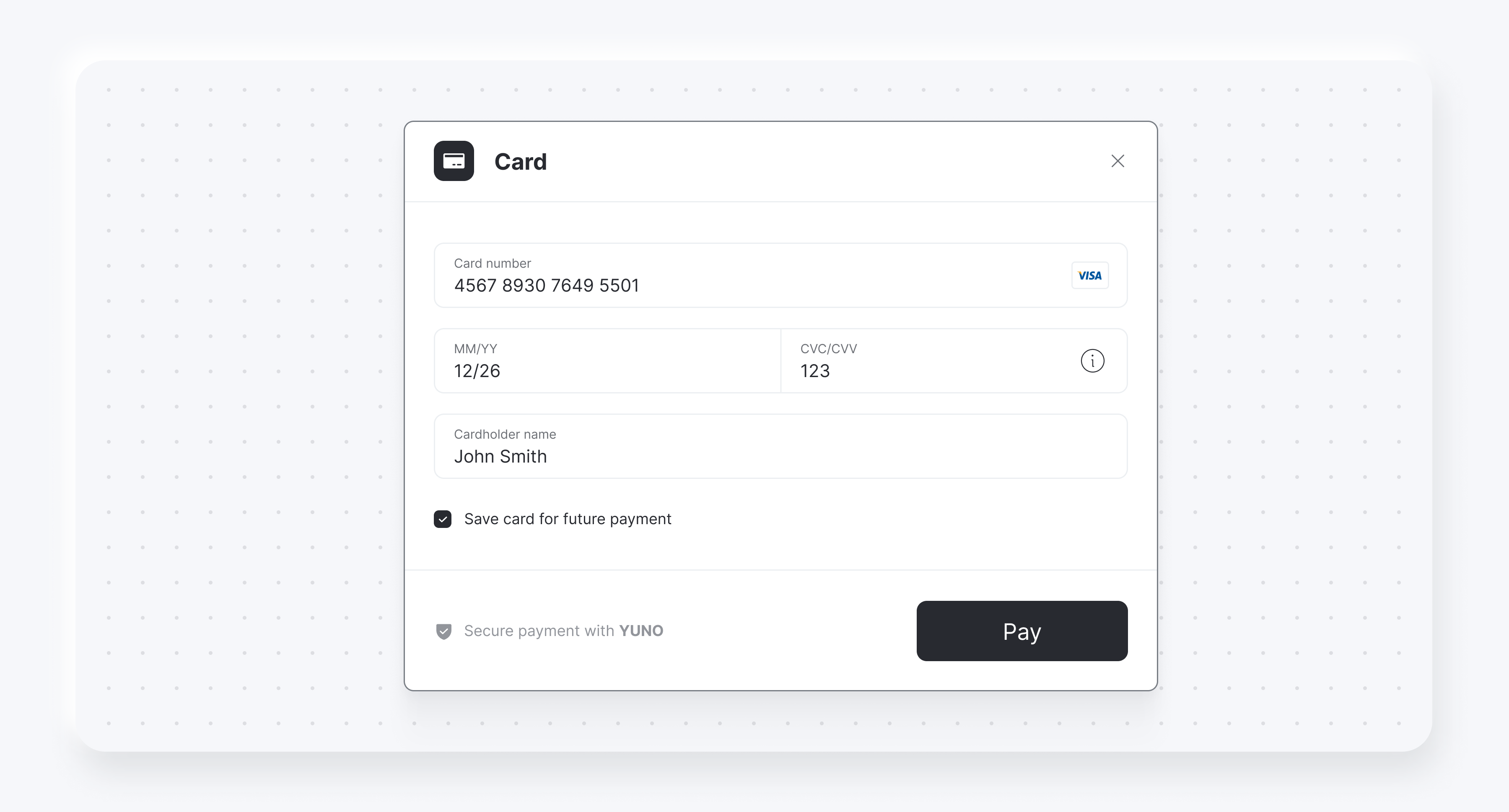
Rendering modes
The following screenshots show the difference between:
- Render modes
modalandelementsfor the payment method list - Render modes
stepandextendsfor the credit card form
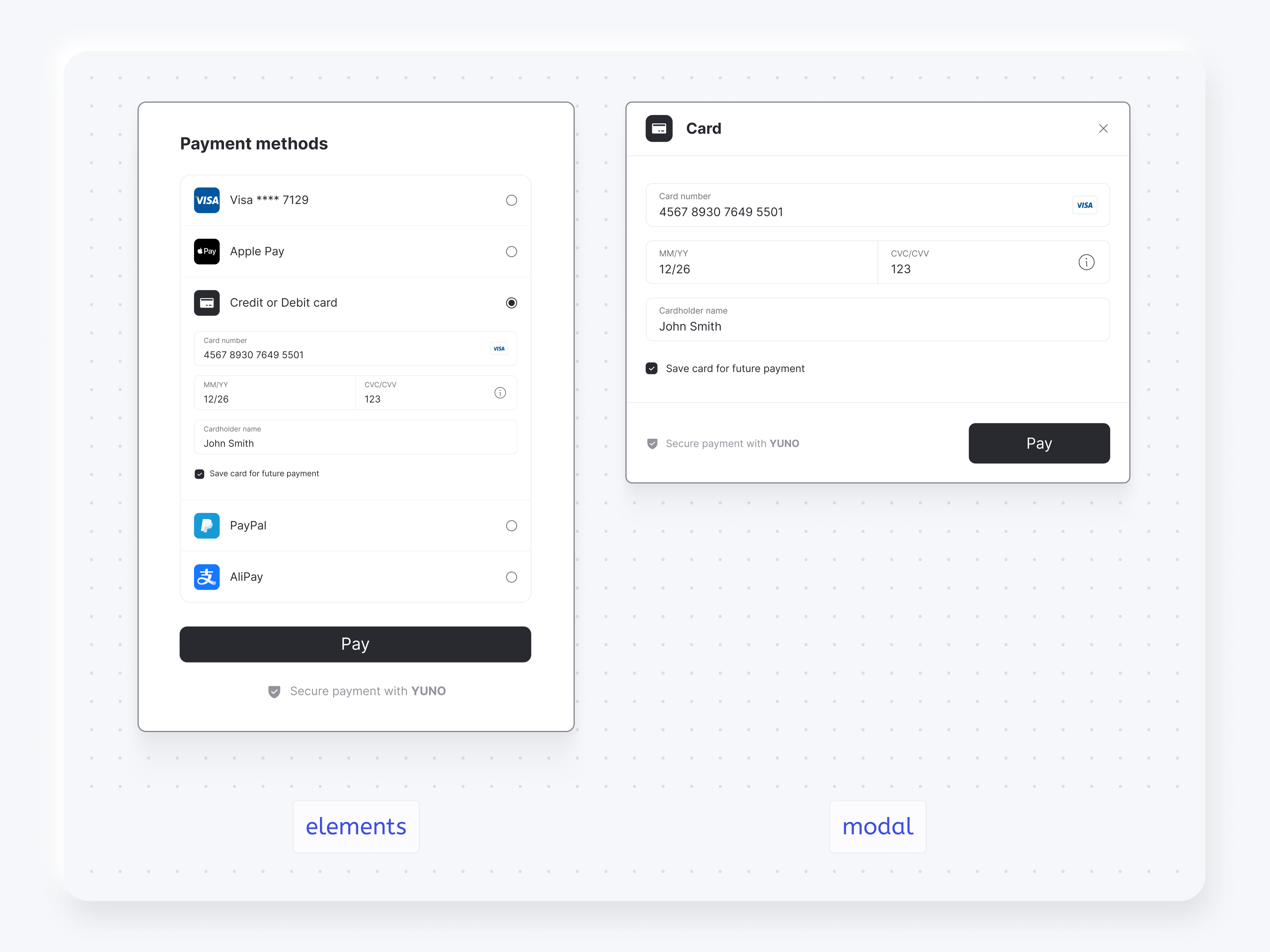
You can also choose one of the render options for the card form, step and extends:
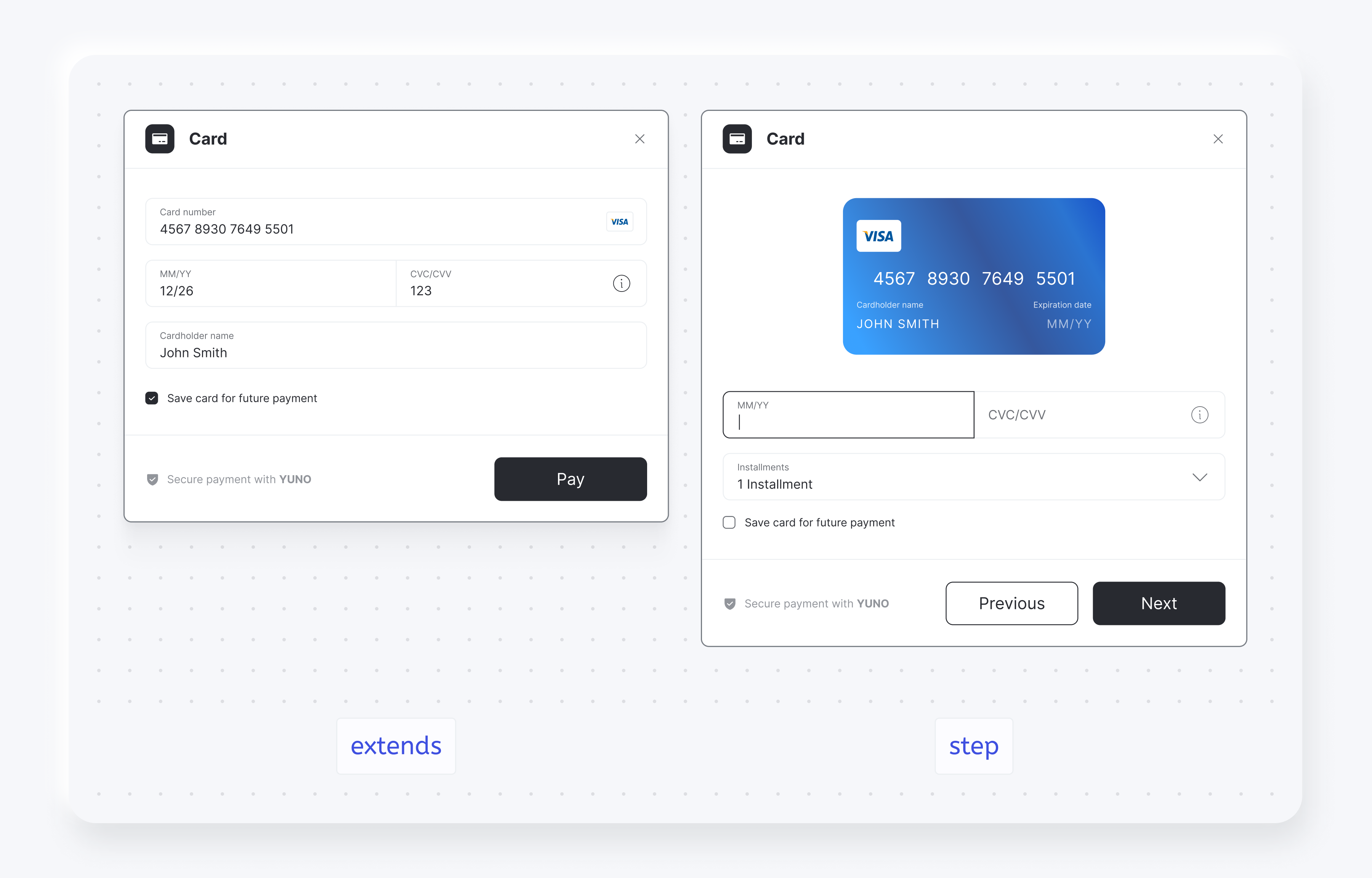
Text payment form buttons
| Parameter | Description |
|---|---|
texts | Provide custom text for payment form buttons to match your application's language or branding: |
yuno.startCheckout({
texts: {
customerForm?: {
submitButton?: string;
}
paymentOtp?: {
sendOtpButton?: string;
}
}
})Persist credit card form to retry payments
If a transaction is rejected, you can use the credit card form to retry a payment after the customer has entered the credit card details. To do this:
- Add the following parameter while initializing the SDK to persist the credit card form after the one-time use token is created:
yuno.startCheckout({ automaticallyUnmount: false, }); - If the transaction is rejected:
- Execute the method
yuno.notifyError()to delete the previously entered CVV for the first transaction - Create a new checkout session and update the SDK with the new one by executing
yuno.updateCheckoutSession(checkoutsession)
- Execute the method
- Continue with the new checkout and one-time use token with the regular payment flow.
Hide pay button
You can hide the Pay button when presenting the card or customer data form. Set showPayButton to false when starting the checkout with the startCheckout function:
yuno.startCheckout({
showPayButton: false,
});The following images show examples of the Customer Data Form with and without the Pay button:
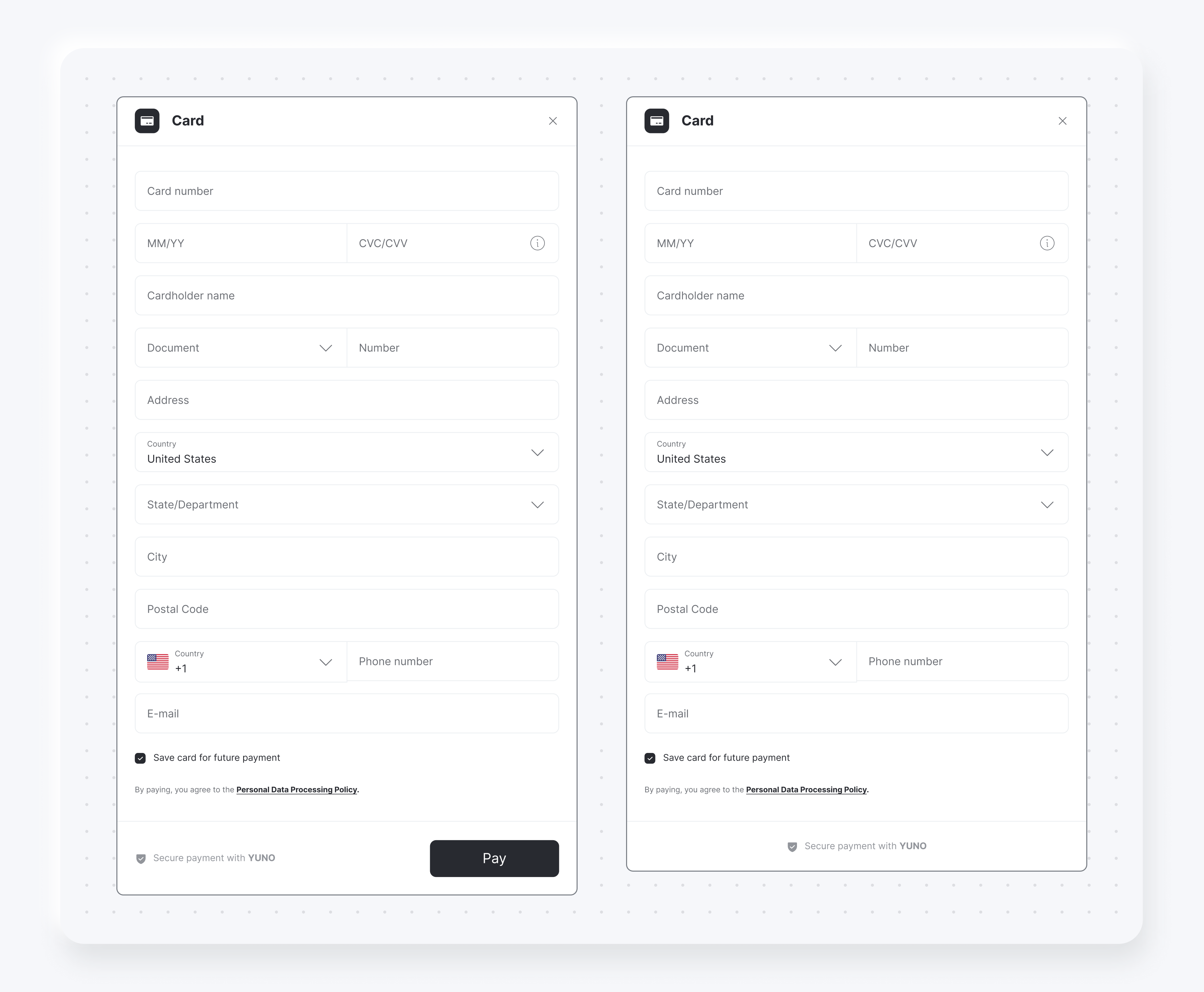
The following images show examples of the Card Form with and without the Pay button:
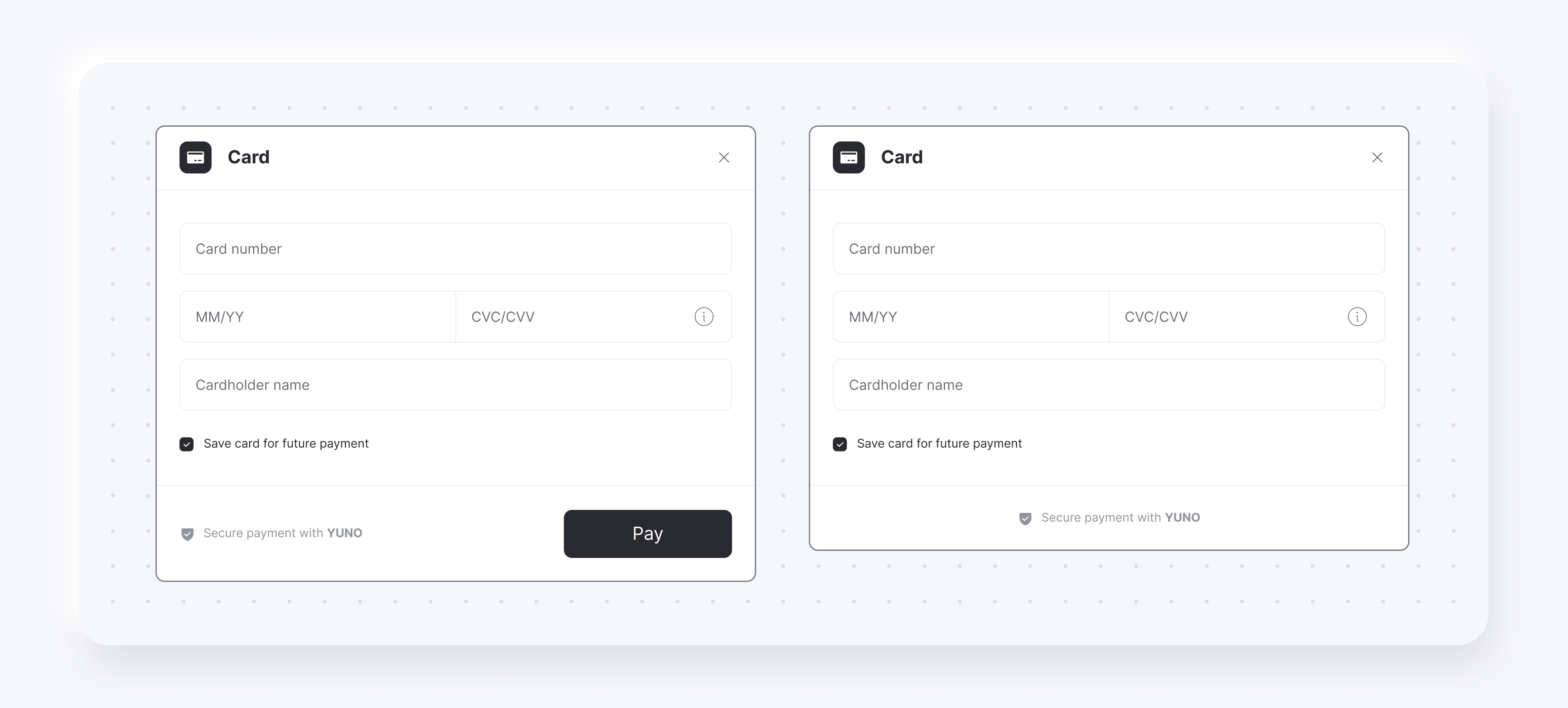
If you hide the Pay button, you need to start the one-time token creation through your code. To create the one-time token and continue the payment in your backend, call the submitOneTimeTokenForm function:
yuno.submitOneTimeTokenForm();Optional initialization options parameter
options parameterThis optional feature is intended for advanced use cases where you need to customize how device identification is handled via cookies.
Starting from Yuno SDK v1.2, the Yuno.initialize function supports a new optional parameter called options. This allows for advanced configuration such as customizing the cookie name used for device identification.
Initialization options
The updated function signature is:
const yuno = await Yuno.initialize(publicApiKey, applicationSession, options);publicApiKey(string): Your public API key.applicationSession(string | undefined): Optional session ID.Recommendation: Leave this as
undefinedso the SDK can generate and manage its own session internally. Only set this if you require a custom session management strategy.options(object | undefined): Optional object for advanced configuration.
Options structure
The options object supports the following structure:
const options = {
cookies: {
deviceId: {
name: "customCookieName",
},
},
};If
deviceId.nameis not specified, the SDK defaults to"yuno"as the cookie name.
Implementation example
const publicApiKey = "your-public-api-key";
const options = {
cookies: {
deviceId: {
name: "custom-device-id",
},
},
};
const yuno = await Yuno.initialize(publicApiKey, undefined, options);What's next?
Learn about the additional configurations from the Full SDK by accessing Complementary Features. You can also access other functions available on the Yuno Web SDK:
- SDK Customizations: Change the SDK appearance to match your brand
- Payment Status: Update the user about the payment process
- 3DS Setup SDK: Integrate 3DS into your payment flow
Stay updated
Visit the changelog for the latest SDK updates and version history.
Updated 7 days ago